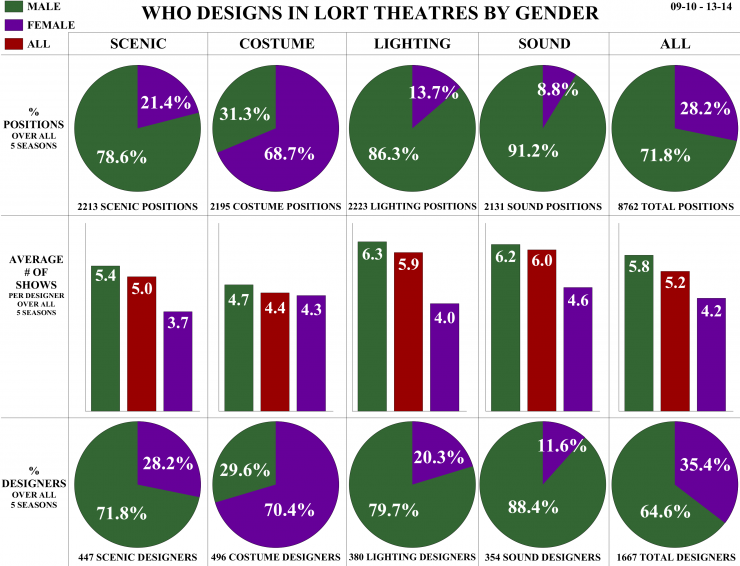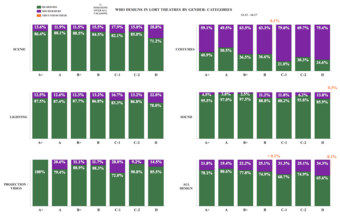Infographic
Who Designs in LORT Theatres by Gender
This article continues our series on Designing Women.
I started working on a project about designers in League of Resident Theatres (LORT) because I wanted to know who gets hired to design in regional theatres in the United States. I wanted to know about racial/ethnic and gender demographics amongst theatre designers. As a person of color, I strongly believe in self-identification. Unfortunately, I couldn’t figure out how to gather enough self-identified demographic information to be statistically representative. So this report looks only at gender, which I generally figured out from artist bios.
This report looks at set, costume, lighting, and sound designers only. While I did track video/projection/multimedia designers, in the early years of the study particularly, many of these designers went without credit and in some cases, no one could actually remember or find any information on who the designer was. I'm happy to share the raw data I found if anyone is interested in trying to figure it out.
I started working on a project about LORT designers because I wanted to know who gets hired to design in regional theatres. I wanted to know about racial/ethnic and gender demographics amongst theatre designers.
While many regional theatres exist outside of the then-seventy four members of the League of Resident Theatres, I decided I wanted to study results from theatres all over the country and with a common collective bargaining agreement with United Scenic Artists, Local USA-829. All categories of LORT Stages, from A+ to D, were included as determined by the LORT-AEA agreement (weekly box office receipts and Tony eligibility) and the LORT-SDC agreement (C Category divided into two by number of seats). Many designers work in a variety of venues and situations, and many with LORT productions being only a small percentage of their overall work.
I collected data from websites, Theatre Communication Group member profiles, Theatre World Book Series, Playbill.com, and various newspaper and internet review sites. After collecting all the data I could find, I wrote each theatre individually to ask for confirmation and corrections. Of the seventy-four theatres, sixty-one responded with confirmation of 2223 of the 2677 productions. All the graphs are based only on confirmed information. I excluded the following: tours, events, galas, Theatre for Youth Audiences shows, and any production that was presented rather than produced.
In cases where theatres run their seasons yearly, the 2010 season was combined with the 2009-10 season for statistical purposes, and so forth. Only lead designers, no assistants or associates, were counted. In cases where multiple designers worked as co-designers, they each got partial credit. For example, Joe and Jane were the co-scenic designers of a production, so they each received 0.5 in the designer counting.
If you work at one of these theatres and would like your specific statistics, please write me at [email protected] from your institutional email, and I’ll happily send them to you.










Comments
The article is just the start of the conversation—we want to know what you think about this subject, too! HowlRound is a space for knowledge-sharing, and we welcome spirited, thoughtful, and on-topic dialogue. Find our full comments policy here
Hi, this is an amazing study, I am working on a similar study in the UK and would love to hear anything more you have written on the topic
Hi Sorcha. I'm currently working on phase two, hopefully out this summer.
http://howlround.com/who-de...
Porsche: I just saw your study in the USA news letter. Thanks so much for doing this research. I've wondered about these issues for a long time. I am a set designer; I have been working as a freelancer, almost always in LORT, for 35 years; I have not had any other job. My feeling now, and I have told this to young designers, is that being a LORT designer, particularly a set designer, is no longer a viable living, even if you're willing to live very modestly; it was when I started. I think a fair amount of that is due to the general decline of the LORT theatres, but your study makes me wonder about the gender disparities. They're pretty prominent. I wonder about 2 things: negotiating style, which I notice others have mentioned, and initial amounts that are offered. There was an interesting magazine article about a year ago (maybe in the Atlantic?) which talked about the reluctance to negotiate on the part of women and the hesitancy to promote ourselves aggressively. I am guilty on both counts. I also suspect that my initial offers are less than the theatres offer men, but I have no way to prove that; I do check with the Union who will provide the fee range that the theatres offer. The other thing I've often felt when I approach a new theatre is that, particularly in a technical field, people assume men will be competent and wonder if women are. Having never been a man, I don't have any way to compare this; but I've suspected it may limit women as they approach new employers. It would be very interesting to know what those initial offers are. It would certainly be interesting to find a way to address this issue with LORT.
-Vicki Smith
Vicki, Thank you for your kind words. You're in the study quite a bit and it's great to see designers reading and responding to my study.
Thank you Porsche for the research you are doing in this area.
Dear Kathy, Thank you so much for your kind words. I don't know if you remember me, but I heard you talk and met you at USITT in 2003 and you were an inspiration. I'm honored that you read this and responded.
Hi Porsche, Yes I do remember meeting you at USITT! If I remember correctly, you were trying to decide where to go for graduate studies. Again, this is an important project you are undertaking. Would love to speak to you more about it, so I will email you directly.
As an African American female lighting designer, I've spent a large part of my life researching blacks behind the scenes. While the numbers are alarming, once you factor in race, particularly black women, they would all be in the low single digits. I would give lighting and scene design less than 1% when it comes to black women designers , and that might be too generous. When we are called, it is usually for the black show. And while black women are excited to get any show, there is this stigma that this is all we can design. (True for both black men and women). I have known too many black women leave the business due to frustration of getting work. With the dwindling of black theatre companies, this means even less design opportunities for black women. Also, it is sad to say that I am one of the few black women lighting designers working in LORT houses. Most of us in USA (less than 10 to my knowledge) know each other and share stories. Maybe situations will improve in the next 22nd century.
As a female scenic and costume designer based in Los Angeles this really resonated with me. Thank you Porsche for doing the research - confirms my experience. Over 90% of the work I do is as a set designer, yet the larger theaters tend to send me scripts asking for my availability only as a costume designer and not for sets. I also read Linda Buchanan's thoughtful piece and I'm inspired to write my own (long) career story. It is very hard to stick with it as a freelance artist with passion and ambitions and also raise children. Along with (male) Tech Directors who assumed they knew better than me and didn't always respect that what was in the drawing was what was intended- (yes- I want you to rip out that header and make it the height I drew it, so extra steps don't land in the playing space please), I also faced scorn as a heteronormative person who had to pick up my kids between rehearsals. Marriage equality is one of the great changes in society that has actually helped women in artistic careers as more combinations of family life are acceptable. I took a bit of a break and although I've been back at it for awhile now, I still feel years behind where I thought I would be at this age, but I love what I do and I'm not going away.
Dear Stephanie, Thank you for your kind words and your story. I'd love to talk with you further about your experiences; could you please send me an email?
Thank you for all of this careful research: I hope it will open some people's eyes to the disparity that has existed for as long as I have worked in theatre. I also wonder with Linda whether the gender balance is improving or getting worse. And what about new hires? I wouldn't blame theatres for hiring the same designers that they have grown to trust over the years (or blame the designers who have worked so hard to cultivate relationships with a group of theatres), but when a theatre hires a new designer, are the gender numbers just as skewed?
Thank you for your kind words and responding to this. New hires are an interesting question. Hmmm.
The LORT contract is posted publicly on the local 829 website. Looking at the rates (page 51), it seems that the minimums for scenic and costume designers are the same. If so, that would mean that, although gender disparity exists in those areas, it's not necessarily reflected as wage disparity. (Interesting, especially since the rates for scenic and costume designers working in other 829-covered areas - film and television - are not equal). You can view the full LORT contract here: http://www.usa829.org/Porta...
Porsche, thank you for your work on this- it's important. And these stats are worse than I expected. When I was a grad student I was the only woman SD in my class. Now I have mostly women students and have long wondered why I don't see that reflected in the professional theatre community. (I refer to this in my story in this series). Do women drop out? Is it about hiring practices? Or both? It would be interesting to know the gender breakdowns in training programs and also as suggested, in the smaller LORT and non-LORT theatres. At what point does attrition occur? Thanks again.
Dear Linda, Thank you for your kind words and responding to my study. I loved your essay. It really me reflect on certain choices I've made about designing in some places due to safety concerns. I'm six years out of grad school, and I just see my peers dropping out at an alarming rate. Maybe as a separate study, it would be interesting to interview people who went through the process of getting an MFA and then left the field/discipline entirely.
This is really interesting Porsche, because I am a Costume Designer who has worked for 11 years, non-Union. I have two degrees: a BA and MFA in Theatre in Technical Design and I want to be able to design at LORT Theaters, I also want to be in the Union and one of the requirements where I live is that you design at a LORT Theater. I went to grad school because I thought I could make connections that would help on that track and it didn't. I keep networking and working at these small theaters and I'm in demand, but I'm not at that higher level yet. I feel frustrated and its like I've hit a wall and I'm on the brink of breaking thru. I don't know if its because here in the Bay Area, Artistic Directors are hiring out of state (because that happens), I don't know if its because Artistic Directors just hire who the Directors want (which is usually the case and some of those Directors are from out of state as well.) Its a lot of factors. I'm proud of myself for staying with it so long, because I have seen many amazingly talented female theater designers who were my classmates from undergrad and grad school who just simply gave up after they graduated because the pay is so low or they don't want to do the hustle of freelancing (which is a challenge). There is just so much at play. Thank you for all the work you did and put it out there for the theatre community! I appreciate it.
Thank you, Courtney, for responding to this piece. I'd love to discuss "the wall" more with you- would you mind please sending me an email?
It'd be interesting to see a count of unique designers, by gender, plotted over time. Would show:
-If the numbers are being distorted much by a few very busy male designers (doubt it.)
-See if the designer pool is shifting over time (hope so.)
To combat the inclination to blame motherhood for the huge disparity of gender shown here, as if as soon as women have children all the other passions in their life become insignificant and drop away, I would argue that the discouragement one feels while living these statistics combined with the life change of having children form the catalyst to finally push women out. Women who do find success before having children or feel like they are progressing towards that and the momentum is in their favor, are much more likely to feel optimistic and find a way to make it work - much the same way as successful male designers who manage work and family.
Boston's Stage Source has just released their report on the 13-14 season, detailing employment of women in a comprehensive list of categories, including designers. http://www.stagesource.org/...
Thank you for posting this Valerie! This helps a lot.
Porsche: thanks so much for doing this work and uncovering one of theatre's "dirty little secrets." Do you think it would be possible to find out the design fees paid to the women v the men? Maybe get 829 on board to look at that?
And the suggestion from another commentir about A/B v. C/D theatre's is interesting too.
Finally, in the lighting category (my area of interest) the percentages of women are lower than my study of Broadway and USA membership ten years ago. Do you think the numbers have actually gone down in that time or is LORT just a unique category?
Thanks again, LE
Hi Linda,
Thank you for your kind words. I think I would need more access than I've currently got to figure out the fees. Either from 829 or from the vast amount of designers themselves. I'm thinking of trying a few more things to figure out for maybe next year's report, but that depends on a lot of factors. I read your blog and feel honored that you read and responded to this. Thank you.
Porsche - as a woman who used to actively design for LORT and no longer does, I'm one of the people that maybe causes these statistics to look the way they do (i.e. I opted out). It would be interesting to find out why other people opt out. Across higher ed, my anecdotal observation is that there is much more parity, so what happens when women leave school and enter the workforce? What are the barriers? (BTW, there is an article written by Betsy Adams coming out in the next issue of TD&T that adresses some of these issues in the lighting field).
Regarding access to data, I think this is something 829 SHOULD get involved in. *If* there is systemic underpayment of a group of their members, one would think they would want that resolved. Whether there is systemic underpayment hasn't yet been shown, but I think we should light a fire under the business reps to look into it!
- Linda
Ok, let's team up on this. I'll send you an email.
I really would love to find out the design fees. As I talk with other designers who are male about asking for more money from theaters, I find male designers are willing to do it more then female designers. I know men negotiate, while women tend to back away from negotiating pay rates. I want to know if Men are getting paid more than Me as a female designer and does it have to do with asking for what they are worth? This is an area that I find that Women have a hard time with.
In my limited experience, the MFA programs are producing many, many talented woman designers, but woman designers are more likely to leave the industry. They leave for a multiple of reasons, but I feel that the most preventable are the challenges of raising young children and maintaining an active design career. What can we do as an industry to make it easier to have young children and work- for designers of both genders?
I've heard this from many, many women - about the challenges of having a family. And to be honest, I have no idea how I would manage having both children and a design career, if that had been my choice. I know one awesome woman who has made it work.
Dear Burke and Megan,
Thank you for reading and responding to my study.
One thing that I think would be helpful is for theatres/directors to just ask. I have a toddler and as soon as people found out, many just stopped calling. When I asked why, some said they couldn't ask a mom to work for so little or with such long hours or be away from home for that long. That's my decision to make, not anyone else's. But by people not calling, it's already been taken away from me.
When I was assisting the late Arden Fingerhut, she told me about being at a tech table with a high profile LORT artistic director who turned to her and said, "shouldn't you be home with your baby?" This kind of implicit (or even explicit) sexism continues to this day -- it isn't all that different from the Nobe prize winning biochemist who said that labs should be gender segregated. Argh!
Agh, that's just horrid.
As a female regional sound designer it's interesting to look at how we have the least percentage of shows, but the most per-show average, which means - the 8% makes us look like a bigger group than we actually are. Thank you for your work showing the disparity.
You're in my study a lot, so thank you for reading and responding.
I did a similar series of posts on these same kinds of numbers for Philadelphia specifically, linking hiring percentages with budget size.
https://swimponypa.wordpres...
https://swimponypa.wordpres...
https://swimponypa.wordpres...
I read your blog- thank you so much for reading and responding to this and posting your data.
for those who continue to ask the question "how do we go about resolving this inequality?"
The answer is rather simple:
Provide opportunities for growth and education. Do more to invite the persons of color, disabled, and female people to do applicable work.
Oh, and actually don't be ok by what this is showing.
This is fascinating. For a little more context it would be really interesting to know the percentage of USA 829 designers that are women and how that percentage breaks down by category. Are regional theaters disproportionately hiring men because the pool is disproportionately male (and vice versa for costume designers) or is there something else going on?
Josh:
In 2005, I did a study of lighting designers that found the percentage of 829 lighting design members was, if memory serves, just under 22%. You can find it in the winter 2005 issue of TD&T. If Porsche's numbers are reflective of the field as a whole, then the representation of women in lighting design has actually declined over the last ten years.
Anecdotally, I'd argue that the pool is disproportionately men because women aren't getting the opportunities that lead them into USA 829.... It's a vicious, vicious cycle.
Interestingly, when you look at higher ed, there is much more parity between men and women in design programs. What happens when they leave school and enter the profession? (BTW, there is an article on this topic, although LD specific) coming out in the next issue of the USITT journal TD&T
To me, this is the real question and would get at the heart of the problem. It is easy to read this data and form conclusions about regional theater hiring practices in a vacuum, but I am pretty sure there are some bigger issues at play here. That isn't to simply let regional theaters off the hook, but these numbers seem like the start of a much larger conversation.
Josh, Thank you for reading this. One important thing to remember is you can design two LORT shows without being/before becoming USA 829. Many of the individuals in this study were not union (in some cases, yet) when they designed their show(s).
Porche - this is great granular info. If you have any thoughts on pursuing the much more complicated issue of racial/ethnic demographics, I would love to hear them. I've been trying come up with a way to canvas/survey/investigate those questions.
dwinitsky, my email is above. If you can email me, I'd love to talk further about this.
Sigh. Thanks, Porsche. Frankly, I didn't think it was possible to find the gender statistics MORE depressing than off Broadway stats by the League of Professional Theatre Women. All best,
ML Geiger
Thank you for reading this, ML!
Thank you Porsche! So many folks have asked me about designer related statistics - I'm glad to have this data to share with them! Is this post itself the full report, or do you have more analysis available elsewhere?
Hi Valerie, I loved your report on WomenArts and thank you for reading this. This is the full report. I may do this again next year, now that I've figured out the how and add on from there. I'd appreciate hearing your suggestions on where to go from here. Thanks again.
Hi Porsche - sent you an email last night - hope to connect soon!
Interesting, thank you for sharing! I recently did a similar project so I'm curious how you decided to count a single designer in multiple disciplines on one show. For example, if someone designed both Costumes and Set for one show did you count them as the full two?
I did count them as the full two. Maybe if there's another round, I'll try to see how often one person doubling in two disciplines happens.
I bet the news is even more depressing when you compare LORT A&B Theatres with LORT C&D Theatres.
I would love to see this data broken down this way as well - I've found in my own data collection work (of directors, writers and union/non-union actors in the San Francisco Bay Area), that when the budgets go up, fewer women are involved in the project. http://www.womenarts.org/no...